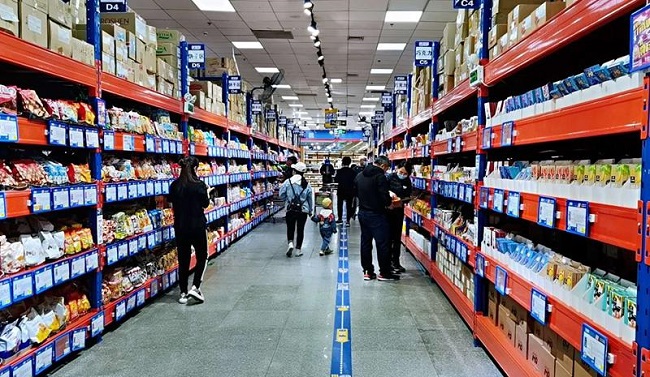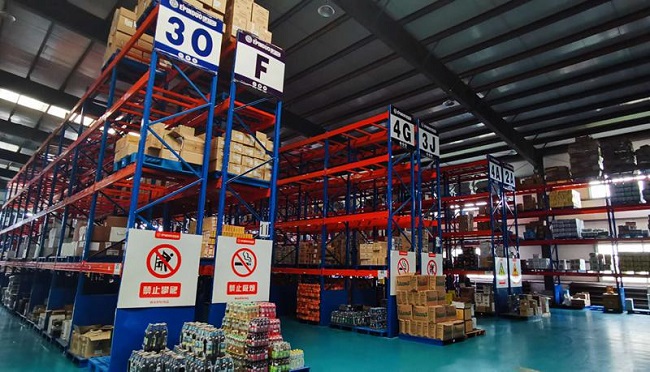Booming e-commerce in border city signals brighter future for China-Russia trade ties
Located in northeast China’s Heilongjiang province bordering Russia, Heihe has witnessed an e-commerce boom in 2020 in the midst of the COVID-19 pandemic. As China’s northernmost free trade pilot area, Heihe has found new paths to growth by capitalizing on its geographic advantages, lifting the China-Russia trade ties to a higher level, enjoying rapid cross-border ecommerce growth.
A wide range of Russian products, such as snacks and cosmetics, have entered the Chinese market, enriching people’s online shopping experience.

Shoppers select imported goods in Epinduo’s store. (People’s Daily Online/Xian Jiangnan)
“Considered the twin city Russia’s Blagoveshchensk, Heihe has exceptional advantages in developing cross-border e-commerce,” said Zhong Huanyu, director of Heihe Cross-border E-commerce Industrial Park. According to Zhong, as Heihe and Blagoveshchensk face each other across the Heilongjiang River (also known as Amur River), imported goods from the other side of the river, such as tiramisu cake, chocolate and other Russian products, can have be delivered in the same-day to Heihe.
Established in 2016 at Heihe Cross-border E-commerce Industrial Park, Epinduo is now China’s leading platform for the sale of Russian goods. In one of Epinduo’s stores in Heihe, hordes of shoppers select imported goods every day which they consider attractive in price and quality.
“At present, there are around 7,000 types of products available at our stores. Roughly all kinds of Russian food products can be purchased here,” said Epinduo’s CEO Jing Quan, adding “the weakening ruble and a pursuit of better living standards have stimulated people’s demand for Russian goods.”

A live streamer demonstrates Russian products for online followers in Epinduo’s store. (People’s Daily Online/Xian Jiangnan)
Along with offline stores, the company has been operating various online shopping platforms such as JD.com, Taobao and Pinduoduo.
Epinduo has also jumped on the bandwagon of participating in live commerce, a fusion of shopping and live streaming. With a handful of live streaming rooms lining the corners of its store, live streamers demonstrate and taste Russian products for their online followers.
According to Jing, e-commerce enterprises in Heihe now use big data systems to predict sales in different regions throughout China, storing goods in multiple warehouses in advance in order to shorten logistic times and reduce costs.

A warehouse in Heihe Cross-border E-commerce Industrial Park. (People’s Daily Online/Xian Jiangnan)
“It used to take customers in Shanghai four or five days to receive the goods. Now it only takes two days and the price is nearly 20 percent lower. Thanks to this business mode, the number of our online customers have increased,” Jing said, noting that in the first eight months of this year, Epinduo’s online sales increased by 2.6 times year-on-year.
Epinduo is not the only company in Heihe that has seen sales jump amid the economic downtrend. In the first half of this year, the trade volume of companies in the Heihe Cross-border E-commerce Industrial Park reached nearly 100 million US dollars, among which the online retail sales increased by 11.2 percent year-on-year.
Heihe is also home to China’s largest China-to-Russia electromechanical devices seller, Liyuanda Group. During the pandemic, the e-commerce platform has helped the company withstand the COVID-19 headwinds.
“Amid COVID-19, our inventory in the Russian market has basically been cleared through online sales,” said Song Zenan, general manager of Liyuanda Group, adding that nearly $440,000 of small-sized devices and accessories have been sold online during the pandemic.

Photo shows the first cross-border highway bridge along the China-Russia border. (People’s Daily Online/Xian Jiangnan)
With the development of the Belt and Road Initiative, the border city continues to open wider to the outside world, with new cross-border infrastructure being built to improve the facilities’ connectivity between China and Russia.
In 2019, the first cross-border highway bridge was built along the China-Russia border. With the capability to transport an estimated 3 million plus tons of cargo and 1.4 million passengers annually, the bridge will unleash the potential for further e-commerce growth.
“As a major infrastructure project between China and Russia, the bridge will promote the building of the cross-border industrial cluster between Heihe and Blagoveshchensk, enhancing friendly economic and cultural exchanges between the two countries,” said Zhang Haipeng, Deputy Director of China (Heilongjiang) Pilot Free Trade Zone Heihe Area.


